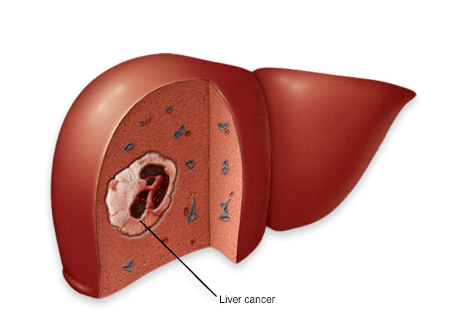Studies show Proton Therapy can reduce side effects and increase overall survival for liver cancer.
ABOUT LIVER CANCER
Liver cancer is the sixth most common cancer worldwide and one of the leading causes of cancer death. In 2019, there were approximately 100,000 people living with liver cancer in the United States.
According to the National Cancer Institute, the 5-year survival rate is just 20.8%. In comparison, more common cancers like breast (90.6%) and prostate (96.8%) have much higher 5-year survival rates.

The most common type of liver cancer is Hepatocellular carcinoma (HCC), a disease in which cancer cells form in the liver tissue. Other types of liver cancer, such as intrahepatic cholangiocarcinoma and hepatoblastoma, are much less common.
LIVER CANCER SYMPTOMS AND DIAGNOSIS
Liver cancer can be hard to diagnose because symptoms often do not appear until the disease has progressed to later stages. Symptoms may include things like fatigue and weakness, yellow eyes and skin, unexplained weight loss, abdominal pain, and pale stools or dark urine.
Tests and procedures used to diagnose liver cancer include blood tests and imaging tests such as CT and MRI. A biopsy involves inserting a thin needle through the abdomen and into the liver to remove a piece of liver tissue. This tissue is then examined in a laboratory to see if it is malignant or cancerous.
LIVER CANCER TREATMENT
Treatment options for HCC include surgery, ablation therapy, immunotherapy, radiation therapy, and others. While surgery may be the best option to cure some liver cancers, it’s not always possible.
A partial hepatectomy, where the cancerous part of the liver is removed, might not be an option if the patient has other liver disease, like cirrhosis. A liver transplant is also difficult because it can take too long for a donor to become available.
“Surgery remains the gold standard,” noted Nina Sanford, MD, and colleagues from Massachusetts General Hospital in Boston. “But donor livers are a scarce resource, and a large proportion of patients are either technically or medically inoperable.”
Traditional radiation therapy has had success historically, but it can also be challenging to deliver, especially for patients with liver damage from hepatitis or cirrhosis. One of the most serious side effects is radiation-induced liver disease (RILD), which can be fatal.
Proton therapy delivers much less radiation to healthy tissue than traditional X-ray or photon-based treatments. As a result, proton therapy is tolerated much better and can reduce side effects, such as RILD, compared to other treatments.
Additionally, studies have shown that proton therapy can improve the overall survival rate for patients.
Laura Dawson, MD, a professor of radiation oncology at the Princess Margaret Cancer Center in Toronto, remarked on the promise protons show for patients with hepatocellular carcinoma, “There is hope for patients with liver cancer, with more treatments becoming available in recent years,” said Dawson. “These studies show that protons, like photons, may be used to treat patients with HCC with a high rate of tumor control and a reduced risk of adverse effects.”
CLINICAL STUDIES
A clinical investigation out of Massachusetts General studied proton versus photon radiation therapy for HCC patients who were not candidates for surgery.1
Researchers followed 133 patients who were treated from 2008 to 2017. The average overall survival for those treated with proton therapy was 31 months, compared to just 14 months for patients treated by traditional radiation. After two years, the overall survival rate for proton patients was 59%, while traditional radiation only had a 28.6% rate.
“In the United States, patients with HCC tend to have underlying liver disease, which could both preclude them from surgery and make radiation therapy more challenging as well. So, having a therapy option that is less toxic could potentially help many patients,” said Dr. Nina Sanford, the studies lead author.
Not only did the study observe improved survival rates, but they also noticed a decrease in radiation-induced liver disease. Patients receiving proton therapy had a 26% lower risk of RILD, as compared with photon radiation (odds ratio, 0.26; P=.03;).6
Sanford and her colleagues concluded the improved overall survival time could be the result of lower occurrence of radiation-induced liver disease.
“Proton radiation therapy delivers less radiation dose to normal tissues near the tumor, so for patients with HCC, this would mean less unwanted radiation dose impacting the part of the liver that isn’t being targeted,” said Dr. Sanford. “We believe this may lead to a lower incidence of liver injury. Because many patients with HCC have underlying liver disease to begin with, it is possible that the lower rates of liver injury in the proton group are what translated to improved survival for those patients.”
LIVER CANCER TREATMENT AT OKLAHOMA PROTON CENTER

The radiation oncologists at Oklahoma Proton Center work collaboratively with other specialists to create a personalized treatment plan for patients with liver cancer. This could include definitive treatment with proton therapy or proton therapy in combination with other treatments.
Dr. John Chang, Medical Director of Oklahoma Proton Center, commented on this approach: “We don’t believe in a one size fits all treatment. Our objective is to personalize the treatment plan for each patient in order to maximize the chance at long-term survival while also minimizing side effects.”
Oklahoma Proton Center is one of the most experienced proton facilities in the country having treated nearly five thousand cancer patients since opening in 2009. Patients have traveled from around the region for treatment, including a number of patients with rare or complicated cancers such as liver cancer. For more information about proton therapy and liver cancer treatment, contact the team at Oklahoma Proton Center.
- Sanford NN, Pursley J, Noe B, Yeap BY, Goyal L, Clark JW, et al. Protons versus photons for unresectable hepatocellular carcinoma: Liver decompensation and overall survival. Int J Radiat Oncol Biol Phys (2019) 105(1):64–72. doi: 10.1016/j.ijrobp.2019.01.076
